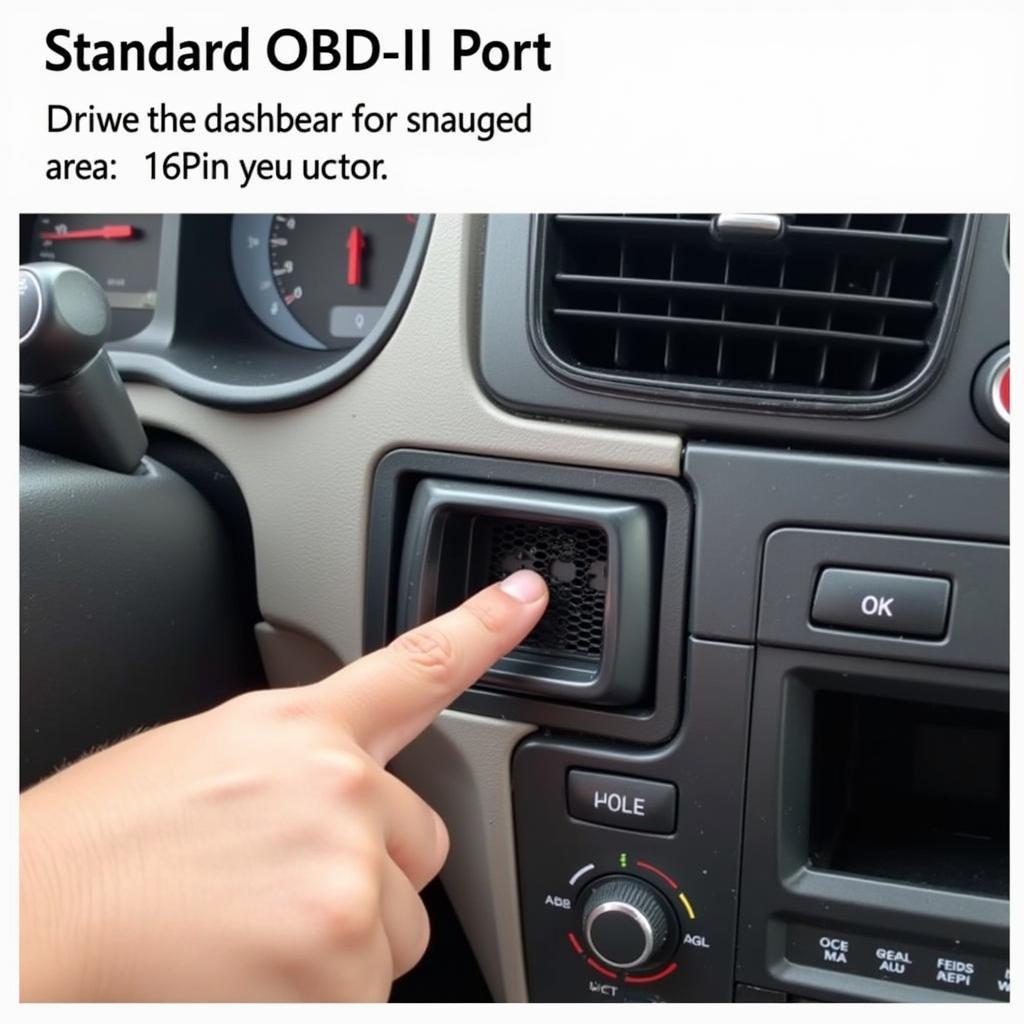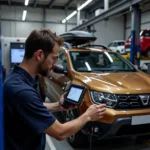The car diagnostic port, often referred to as the OBD-II port, is a crucial interface for understanding your vehicle’s health and performance. It’s the gateway for mechanics and car enthusiasts alike to access a wealth of information about the inner workings of a car. This article dives deep into the world of car diagnostic ports, exploring their functions, locations, and the valuable insights they provide. After reading this, you’ll be better equipped to understand how this small port plays a big role in car maintenance and repair. We’ll also discuss how advancements in diagnostic technology are shaping the future of car repair. For instance, did you know some diagnostic tools can even be accessed remotely?
Modern vehicles are complex machines with intricate electronic systems controlling everything from engine performance to safety features. The car diagnostic port allows you to tap into these systems, retrieve diagnostic trouble codes (DTCs), and gain a comprehensive understanding of your vehicle’s status. This empowers you to make informed decisions about repairs and maintenance, potentially saving you time and money. Understanding your car’s diagnostic port can be likened to having a direct line of communication with your vehicle, allowing it to tell you exactly what’s going on under the hood. Think of it as your car’s own personal translator, converting complex electronic signals into understandable information. You can even find specific information about the diagnostic port for certain car models, such as the toyota sprinter inside car diagnostic port.
What is a Car Diagnostic Port and How Does it Work?
The car diagnostic port, standardized as OBD-II (On-Board Diagnostics, Second Generation) in 1996, is a 16-pin connector typically located under the dashboard on the driver’s side. This port provides access to the vehicle’s onboard computer and its stored data. When a problem arises within a vehicle’s system, a diagnostic trouble code (DTC) is generated and stored in the computer’s memory. By connecting a diagnostic scan tool to the OBD-II port, mechanics and car owners can retrieve these codes, which pinpoint the source of the issue.
Beyond simply retrieving DTCs, the car diagnostic port allows access to real-time data from various sensors throughout the vehicle. This data can include engine speed, coolant temperature, fuel pressure, and much more, providing a dynamic view of the car’s performance.
Locating Your Car Diagnostic Port
Most car diagnostic ports are located under the dashboard on the driver’s side, often near the steering column. However, the exact location can vary depending on the make and model of your vehicle. Some vehicles may have the port located behind a panel or in the glove compartment. If you are unsure of the location, consulting your vehicle’s owner’s manual is the best way to find it.
Using the Car Diagnostic Port for Troubleshooting and Maintenance
The car diagnostic port isn’t just for mechanics; car owners can also use it to perform basic diagnostics and monitor their vehicle’s health. Affordable OBD-II scanners are readily available, allowing you to check for trouble codes and access real-time data. This can be particularly helpful for identifying issues before they become major problems, potentially saving you costly repairs down the road. Services like a car diagnostic test cape town r250-test report offer professional diagnostics at reasonable prices.
What Information Can You Get From the Diagnostic Port?
- Diagnostic Trouble Codes (DTCs): These codes provide specific information about the nature of a fault within the vehicle’s systems.
- Freeze Frame Data: This snapshot of the vehicle’s operating parameters at the time a fault occurred provides valuable context for diagnosis.
- Real-Time Data: Live sensor readings allow for monitoring various vehicle functions, such as engine speed, temperature, and fuel pressure.
- Oxygen Sensor Data: Information about the performance of the oxygen sensors is crucial for diagnosing emissions-related issues.
The Future of Car Diagnostic Ports
As vehicles become increasingly sophisticated, so too will the technology surrounding the car diagnostic port. We can expect to see more advanced diagnostic tools and software that provide even more detailed and insightful information. Remote diagnostics, where mechanics can access a vehicle’s data remotely, are already becoming a reality. This allows for faster and more convenient diagnostics and repairs, improving the overall car ownership experience. Some areas already offer specialized services like a car diagnostic test port shepstone.
“The car diagnostic port is evolving from a simple code reader to a comprehensive vehicle health monitoring system,” says John Smith, Automotive Engineer at Advanced Auto Solutions. “This technology empowers both mechanics and car owners to make more informed decisions about vehicle maintenance and repairs.”
Conclusion
The car diagnostic port is an essential tool for understanding and maintaining your vehicle’s health. From retrieving trouble codes to accessing real-time data, this small port provides valuable insights into the complex workings of your car. By understanding the function and potential of the car diagnostic port, you can stay ahead of potential problems and ensure your vehicle remains in optimal condition. Utilizing resources like a car diagnostic ibd8 port can further enhance your diagnostic capabilities.
FAQ
- What is the OBD-II port? The OBD-II port is a standardized diagnostic port found in most vehicles manufactured after 1996.
- Where is the car diagnostic port located? It is usually located under the dashboard on the driver’s side, but can vary depending on the vehicle.
- What can I do with a car diagnostic scanner? You can retrieve trouble codes, view freeze frame data, and access real-time data from various vehicle sensors.
- Do I need a professional to use a car diagnostic scanner? No, affordable and user-friendly scanners are available for car owners.
- What is the future of car diagnostics? Expect to see more advanced tools, remote diagnostics, and even more detailed data analysis.
- Why is understanding the car diagnostic port important? It empowers you to make informed decisions about maintenance and repairs, potentially saving you time and money.
- Can I clear trouble codes myself? Yes, most scanners allow you to clear codes, but it’s important to address the underlying issue causing the code.
Common Car Diagnostic Port Issues
- Loose Connection: Ensure the scanner is firmly connected to the port.
- Power Issues: Check the scanner’s power source and the vehicle’s battery.
- Compatibility: Verify that your scanner is compatible with your vehicle’s make and model.
Further Reading
For more information, you might find articles on specific car models and diagnostic procedures helpful.
Need Help?
Contact us via WhatsApp: +1(641)206-8880 or Email: [email protected]. Our 24/7 customer support team is ready to assist you.



